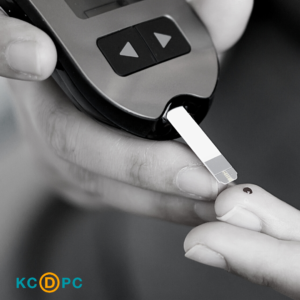Type 2 diabetes is a relative insulin deficiency with an increased
insulin resistance. People with type 2 diabetes make some insulin, but have an increased resistance to insulin due to two main factors: excessive body fat and lack of exercise. Through several mechanisms, increased fat will increase both blood glucose and blood cholesterol. A sedentary lifestyle increases risk of diabetes, and decreased lean muscle contributes to insulin resistance. Studies have found that even modest exercise can
reduce risk of developing diabetes by 10-30%.
Patients often come in with symptoms of fatigue, dry mouth, and increased urination. The body attempts to normalize blood glucose by dumping huge amounts of glucose into the urine. This causes dehydration, and patients drink large amounts of water or other liquids in response.
During residency, I diagnosed a middle-aged male with diabetes who had increased fatigue and an increase in thirst and urination. His A1c was over 12, meaning his average blood glucose over the past 3 months was over 300. When I told him his diagnosis he was highly motivated and bought into the treatment. He lost 40 pounds, stopped drinking beer as often, started jogging, removed processed carbs from the diet, and took his medicine. His A1c after 6 months was 5.4, a remarkable improvement.
This model patient (who is real, I promise) never had to take insulin, and has decreased his insulin resistance so much that he has now stopped his diabetes pill and has kept his A1c under 6.0 with lifestyle alone.
Lifestyle Modification
Diet and exercise are easier said than done. There are many obstacles, whether it is time, cost, or access. Many of the patients that I have treated live at or below the poverty line, and simply don’t have the luxury of a local supermarket with fresh produce or a safe neighborhood to take an evening walk. These issues and more are what are called social determinants of health, which you can read more about
here.
A diabetic diet should be high in lean protein and vegetables, with limited high fiber fruits and complex carbs. Many patients do not realize how bad many common foods are for their diabetes. An 8 ounce glass of apple juice has more processed sugar than a Snickers bar. Carbohydrates should be complex, meaning high in fiber, which causes the blood sugar to rise slower when digested. This slow rise allows insulin to respond better than when there is a large spike.
A useful tool for determining how “good” a carb is is the
glycemic index (GI), which gives food a score of 1 (great) to 100 (very bad!) based on how fast it will spike blood sugar. For example, white bread has a GI of 75, while multigrain bread (the stuff with oats and seeds all the way through it, not just the top) has a score of 53. Harvard Health has a nice list of common foods with their estimated GI
here.
Cells can use glucose without the help of insulin while one is exercising. Exercise can aid in weight loss, and improve metabolism and lean muscle mass, all of which help control diabetes. It is important to have both aerobic exercise and strength training. A fellow resident physician in my program has a patient who significantly lowered their A1c by simply walking up and down the stairs of their apartment and taking a lap around the parking lot 3 times a day.
Optimal exercise per the American Diabetic Association (ADA) is 30 minutes of moderate aerobic exercise 5 times a week, for a minimum of 150 minutes per week, which is also the American Heart Association recommendation. Moderate intensity exercise is described as “
being able to talk, but not sing” during the activity. For many, this is a difficult goal, and I never make this the goal for a patient that is sedentary. It is important to take small steps that become habits one can build upon. I would rather a patient work out for 30 minutes twice a week for life than to get 150 minutes a week for a month and then quit entirely.
Why Does it Matter?
Diabetes is the 7th highest cause of death in America and it contributes to the #1 and #5 causes, heart disease and stroke. Over 100 million people in America have either pre-diabetes or “full blown” diabetes.
It turns out your cells can only handle so much sugar before it starts to damage them. Glucose is sticky, both outside and inside the body. In a process called glycosylation, glucose is bonded to other molecules, and it is important for many biochemical processes. This is how we get an A1c, which is a measure of how much glucose has been stuck to your red blood cells over the past 3 months.
High blood glucose causes nerve damage and blood vessel damage. Nerve damage is called neuropathy, and why it occurs is not exactly known. Some diabetics develop severe, painful neuropathy with decent control on their diabetes, while others will never develop neuropathy even with poor diabetic control. Diabetes is one of 4 conditions known to be a major risk factor vascular (blood vessel) disease. The other 3 are high blood pressure, high cholesterol, and tobacco use. Uncontrolled elevations in blood glucose cause inflammation and destruction of the blood vessels, and increase risk of clots (thrombus) that travel to the heart and brain causing heart attacks and strokes. The inflammation and damage also occurs in the kidneys, which have intricate networks of microscopic filters to keep your blood healthy. Diabetes is a leading cause of kidney failure. Bottom line, your body doesn’t like diabetes, and diabetes doesn’t like your body.
So what should you do? Simple. Eat well, exercise, maintain a healthy weight, don’t smoke, and see your doctor for screening labs.
Hazen Short, MD


Great information Hazen. If I can’t get my husband to eat fruits little vegetables what are highly suggested foods? He is on a lot of medication for his diabetes including insulin. I feel he stays active, numbers seem to stay up too high.